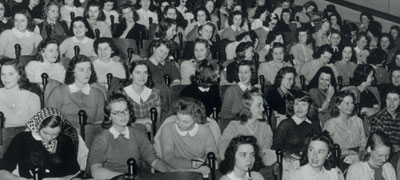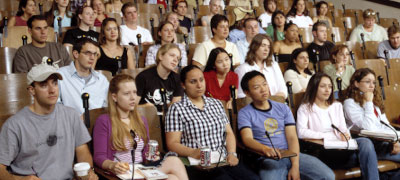Some Things Never Change, or Do They?
As you read these words, Art 105–106, Vassar’s long-running course in the history of art and architecture, will be starting up once again. The course is almost 80 years old and remains one of the most popular. It still tries to teach students new habits: how to look hard and long at works of art and architecture. Alumnae/i often ask about the continued health of the course (it’s doing very well) or reminisce about the idiosyncrasies of great lecturers. Sometimes they even remember especially difficult questions from their exams, and they almost always recall the many hours of memorization, alone or in groups in the corridors of Taylor Hall.

But are students memorizing the same objects today that they did many years ago? And are they remembering the same things about them? The answer is no. From a brief survey of the syllabi of 60 years ago, two differences seem to be true. Compared to the current syllabus, the old ones show more works by the “great masters.” In individual cases it may be no more than one or two paintings, but over the year it adds up — eleven works by Rubens, eight sculptures by Michelangelo, eight paintings by Leonardo da Vinci and so on. And there seems to have been more time to fill out certain periods. Hogarth, Reynolds, and Gainsborough from the British 18th century, to be sure, but also three paintings by Sir Henry Raeburn — hardly a household name! The syllabus of 1941–42 has 11 sculptures from the French late 16th and early 17th centuries (Goujon, Pilom, Girardo, Coysevox, Coustou). My predecessors in architectural history during the 1930s dealt with many more countries than I seem able to fit into my allotment of Renaissance lectures. In addition to the obvious Italian masters — Brunelleschi, Alberti, and Bramante — there was room for some French, Spanish, German, and English architecture from the same period!
Such comparisons are interesting, but they fail to account for other important changes. New faculty bring new interests, and wholly new areas have been opened. The addition of a full-time Asianist in 1994 led to the inclusion of Japanese and Chinese art for the first time. And a specialist in African-American art, who joined the faculty a couple of years later, brought her material into the course. Other changes are more ruthless if less visible. Pressure to change lecture schedules comes from the relentless movement of the clock. The 20th century, perforce, occupies more space in the syllabus; thus, the chronological break point at mid-year has shifted. In 1937, for example, the second semester started with the early Renaissance (around 1400); today it starts with the high Renaissance (around 1500).

Day-to-day work in the course has changed, too. With the construction of the art center, and as a result of the generosity of alumnae/i, more time can be spent in section meetings with original works of art in Vassar’s own collection. Compared to past years, students probably spend less time studying together. Images still go up on the walls, but now they are confined to a special study room in the Art Library and the preferred study location is the computer. A database makes it possible for students to study the works of art and architecture on their dorm computers. In the coming years, we will need to address the ways that the advantages of group study can be brought together with the advantages of the computer.
The course has changed in other ways, as well. In the 1930s, the syllabus came in a colored cardboard cover with pithy evaluative commentaries for each artist: Titian, the syllabus explained in 1937, “Supreme Technical Performance in Entire Range of Accomplishment; Magnificence, Vitality; Golden Tonality”; or Veronese, “Continuation of Early Venetian Pageant Painting, Transformed into Sumptuous High Renaissance Decoration; Silver Tonality.” This format continued until 1953–54 when a new syllabus appeared that read more like a book. It combined a summary paragraph about each artist, with an historical introduction to each period. It seems, at first, like a minor change, but what did it mean? What happened? And why?
This change in the syllabus corresponded to a major shift in teaching methodology that had already been underway for more than a decade. The key figure was Richard Krautheimer. Trained in Germany, Krautheimer was among the many émigré scholars who had come to the U.S. before and during the war. He joined the faculty in 1937, and his approach to art was novel. “He liked to talk about style, and we became hypnotized by the analysis of style as style,” said Esther Gordon Dotson ’39, an art department faculty member from 1943 to 1954. “[Before,] the course had been about the values in the works but not about the stylistic systems.”
Together with Linda Weinberg Nochlin ’51, who had been her student in Art 105 and was on the faculty from 1952–78, Dotson rewrote the syllabus. “We felt very conspiratorial,” she said. “The syllabus as it was written was almost an invitation to learn the formulae. We thought it ought to require a little more work.” They had an advantage. “Partly it was that Linda and I had gone through the system, and we knew what was the matter with it. The old syllabus was about progress. It was very much oriented to quality in the Harvard tradition.”
Despite their trepidation, the changes proved popular — so popular that the methodological revolution reflected in the Art 105–106 syllabus by the “conspirators” of 1953–54 is still the foundation for the course a half century later. Though the faculty often presents recent research or fresh interpretative approaches in their discussion of the works of art and architecture, the course remains about learning to see and learning to talk and write about the stylistic forms of works of art. With film, computers, and virtual reality environments confounding the task of distinguishing the significance of visual imagery, the need to learn how to look is more urgent than ever. “Looking carefully isn’t much encouraged in our society,” said Dotson. But Art 105–106 still demands it.
Adams is Mary Conover Mellon professor in the history of architecture in the Art Department. Together with Lisa Collins, assistant professor of art, he will be coordinating Art 105–106 this year.
Photos by Will Faller and courtesy Special Collections, Vassar College Libraries
